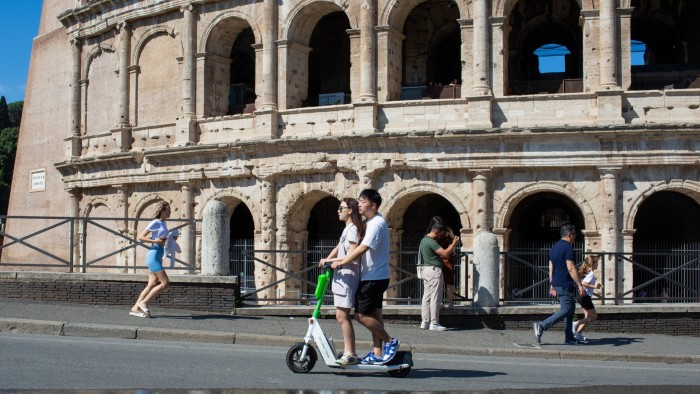Unlock the Editor’s Digest for free
Roula Khalaf, Editor of the FT, selects her favourite stories in this weekly newsletter.
It is not unknown for rapidly growing new business models to bump up against regulatory constraints. Uber, alongside much of the gig economy, got caught up in a debate over workers’ rights. Airbnb has come under pressure in Barcelona, among other cities, amid fears about overtourism and housing costs.
Now add e-scooters to the list. In Italy, new laws will force riders to wear helmets and carry insurance — restrictions that operators have said will depress demand. Italy’s move to tighten rules is not an entirely isolated occurrence. Paris last year said “non merci” to rented e-scooters following a referendum.
The impact of Italy’s rule change will only become apparent when the details are released. But the real question for operators such as Dott and Tier, which merged earlier this year, and, of course, Uber-backed Lime, is whether this is a sign of a brewing backlash.
Shared micromobility (as the practice of renting out e-scooters and bikes is known) has certainly become a bigger and more visible phenomenon. In 2023, people in the US and Canada took 157mn bike or scooter trips, up a fifth compared with the year before.

The good news is that e-scooter safety is improving, at least measured in relation to the number of trips taken. In Italy, e-scooter accidents per 100,000 rentals fell to 1.39 in 2023, down from 1.56 in 2022, according to Osservatorio Nazionale Sharing Mobility. Lime reckons that, globally, its ratio of total incidents to total trips fell 22 per cent over the same period.
The bad news, however, is that e-mobility clearly does have an image problem. Its role in reducing traffic and pollution is barely part of the discourse, which is instead dominated by complaints over reckless driving and parking. Enforcing road rules is the job of local authorities, rather than companies. If mobility companies want to avoid obstacles and bans, however, they would be well advised to help.
After all, the industry can ill-afford measures that would dent demand. Making money from e-scooters is not easy — and requires scale. A bigger vehicle base means a lower unit capex cost and the opportunity to optimise the process of charging, maintaining and moving scooters about. A deep pool of demand is required to pay back the upfront cost of the hardware.
Companies are still at a nascent and fragile stage. Former high-flyer Bird filed for bankruptcy protection as recently as the end of 2023. Longer-lasting vehicles and increasing scale are helping companies to inch towards profitability, as Lime’s $90mn of positive — albeit adjusted — 2023 ebitda suggests. But the industry, as a whole, won’t survive many road bumps.


